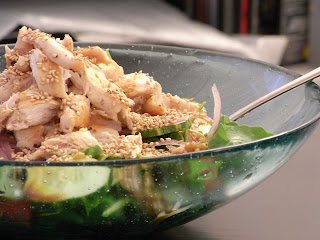
This is from Jaden Hair's blog Steamy Kitchen and the original recipe, I believe, is from here. Christmas is just around the corner, I have no money to squander on shopping and I already have ginger cake, caramel cookies, Ourson Guimauve (chocolate covered marshmallow bears), a box of Crema Catalana and some French pralines lying around. Since everyone else is busy with Christmas preparations and their families, I have nothing better to do than bake or watch reruns of 'Wallander' in Swedish with English subtitles - so what am I going to do?
Bake something savoury!
This was pretty interesting because it was like making a fake sourdough starter and when I woke-up in the morning my sticky ball of dough had swelled up pretty high, had completely lost its shape and I saw a horizon of bubbly exquisitely soft dough sitting inside my plastic bowl. I guess I should have taken a photo of this, but I didn't want my yeast to catch a cold because it's pretty cold indoors in Spain in the winter and so I went right ahead and folded it three times as Jaden instructed and put the dough (which firmed-up nicely) into a clean oiled plastic container for its second rise. I used a spatula instead of wet hands though. It's a technique Ronny uses when making his sourdough bread, which has a much sticker and softer dough than the kind I make.
Did I mention it's been raining pretty heavily here?
Costa del Sol does not have the infrastructure for heavy rain, so when it does rain, it's wise to avoid going outdoors to avoid the floods. Let's not even mention all those careless drivers who do not have rain tires who skid around on the wet streets. Some of these cars used to have tires that could handle the rain, but they're in bad need of getting new tires and they haven't done this because the economy isn't good and the Mediterranean Carpe Diem culture does not entail spending your money on 'safety' first, because it's not really a fun way to spend your money.
To add insult to injury it's Christmas season, so you see - money gets spent on presents and feasting rather than on new tires and it's pretty damn dangerous going outside in the rain here.
Anyway being a glutton I threw caution to the wind and hiked to Torremolinos to buy supplies and took the taxi back as my backpack was laden with kilos of food. It was worthwhile though because I managed to find some pretty nice green olives* at the grocer.
I wasn't too keen on oiling my oven paper, so I dusted it with corn flour instead. After all, the dough was already swimming in extra virgin olive oil during its second rise. Thing is, the oil that I painted the sides of the plastic bowl seems to have drizzled down to create a pool on my dough. Next time I'm going to be careful about using as little oil as possible when 'oiling the sides of the bowl'.
Everything went as Jaden said. The dough was soft and stretchy and I laid them out and embedded them with the goodies and sprinkled them with 'Sal en Escamas' (salt flakes) then...I realized my oven's highest setting was 250C when the recipe called for 260C (500F). Oh well. Next time I buy an oven, I guess I'll just have to buy a better one.
Anyhow they went in and I set the timer on for 15 minutes first to see how they were doing and baked them for a total of 30 minutes. We had these for brunch with some Brie cheese and they were delicious!
I delivered two of the loaves to our neighbor when they were still fresh out of the oven and said 'Feliz Navidad' to them and was rewarded with the lovely smiles on their faces.
*Green olives with pits in them. They come in these plastic containers with yellow handles and I have only ever seen them sold in olive producing countries like Spain. I prefer these to the canned or bottled varieties which you can get in any part of the world these days. I of course removed the pits before I embedded them into my Stecca.



































